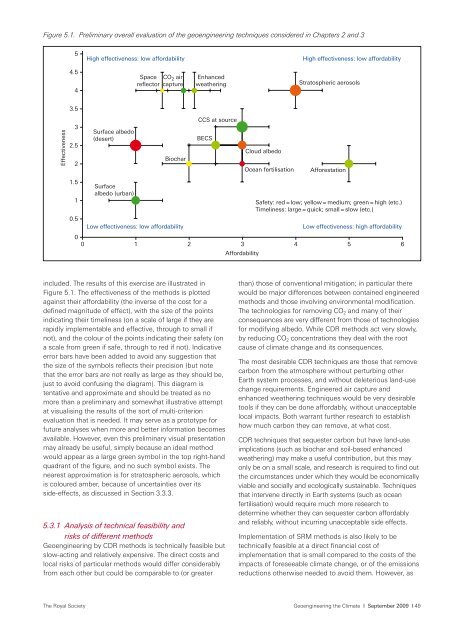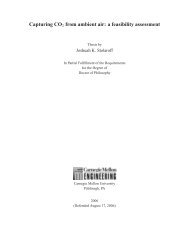Royal Society - David Keith
Royal Society - David Keith
Royal Society - David Keith
You also want an ePaper? Increase the reach of your titles
YUMPU automatically turns print PDFs into web optimized ePapers that Google loves.
Figure 5.1. Preliminary overall evaluation of the geoengineering techniques considered in Chapters 2 and 3<br />
5<br />
High effectiveness: low affordability<br />
High effectiveness: low affordability<br />
4.5<br />
4<br />
Space CO 2 air<br />
reflector capture<br />
Enhanced<br />
weathering<br />
Stratospheric aerosols<br />
3.5<br />
Effectiveness<br />
3<br />
2.5<br />
2<br />
Surface albedo<br />
(desert)<br />
Biochar<br />
CCS at source<br />
BECS<br />
Cloud albedo<br />
Ocean fertilisation<br />
Afforestation<br />
1.5<br />
1<br />
0.5<br />
Surface<br />
albedo (urban)<br />
Low effectiveness: low affordability<br />
Safety: red = low; yellow = medium; green = high (etc.)<br />
Timeliness: large = quick; small = slow (etc.)<br />
Low effectiveness: high affordability<br />
0<br />
0 1 2 3 4 5 6<br />
Affordability<br />
included. The results of this exercise are illustrated in<br />
Figure 5.1. The effectiveness of the methods is plotted<br />
against their affordability (the inverse of the cost for a<br />
defined magnitude of effect), with the size of the points<br />
indicating their timeliness (on a scale of large if they are<br />
rapidly implementable and effective, through to small if<br />
not), and the colour of the points indicating their safety (on<br />
a scale from green if safe, through to red if not). Indicative<br />
error bars have been added to avoid any suggestion that<br />
the size of the symbols reflects their precision (but note<br />
that the error bars are not really as large as they should be,<br />
just to avoid confusing the diagram). This diagram is<br />
tentative and approximate and should be treated as no<br />
more than a preliminary and somewhat illustrative attempt<br />
at visualising the results of the sort of multi-criterion<br />
evaluation that is needed. It may serve as a prototype for<br />
future analyses when more and better information becomes<br />
available. However, even this preliminary visual presentation<br />
may already be useful, simply because an ideal method<br />
would appear as a large green symbol in the top right-hand<br />
quadrant of the figure, and no such symbol exists. The<br />
nearest approximation is for stratospheric aerosols, which<br />
is coloured amber, because of uncertainties over its<br />
side-effects, as discussed in Section 3.3.3.<br />
5.3.1 Analysis of technical feasibility and<br />
risks of different methods<br />
Geoengineering by CDR methods is technically feasible but<br />
slow-acting and relatively expensive. The direct costs and<br />
local risks of particular methods would differ considerably<br />
from each other but could be comparable to (or greater<br />
than) those of conventional mitigation; in particular there<br />
would be major differences between contained engineered<br />
methods and those involving environmental modification.<br />
The technologies for removing CO 2 and many of their<br />
consequences are very different from those of technologies<br />
for modifying albedo. While CDR methods act very slowly,<br />
by reducing CO 2 concentrations they deal with the root<br />
cause of climate change and its consequences.<br />
The most desirable CDR techniques are those that remove<br />
carbon from the atmosphere without perturbing other<br />
Earth system processes, and without deleterious land-use<br />
change requirements. Engineered air capture and<br />
enhanced weathering techniques would be very desirable<br />
tools if they can be done affordably, without unacceptable<br />
local impacts. Both warrant further research to establish<br />
how much carbon they can remove, at what cost.<br />
CDR techniques that sequester carbon but have land-use<br />
implications (such as biochar and soil-based enhanced<br />
weathering) may make a useful contribution, but this may<br />
only be on a small scale, and research is required to find out<br />
the circumstances under which they would be economically<br />
viable and socially and ecologically sustainable. Techniques<br />
that intervene directly in Earth systems (such as ocean<br />
fertilisation) would require much more research to<br />
determine whether they can sequester carbon affordably<br />
and reliably, without incurring unacceptable side effects.<br />
Implementation of SRM methods is also likely to be<br />
technically feasible at a direct financial cost of<br />
implementation that is small compared to the costs of the<br />
impacts of foreseeable climate change, or of the emissions<br />
reductions otherwise needed to avoid them. However, as<br />
The <strong>Royal</strong> <strong>Society</strong><br />
Geoengineering the Climate I September 2009 I 49








